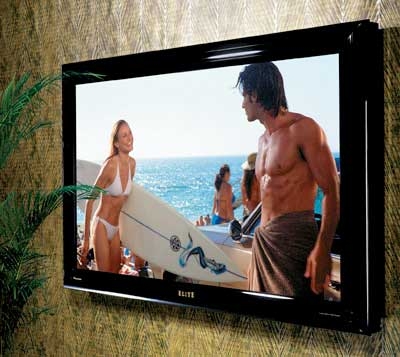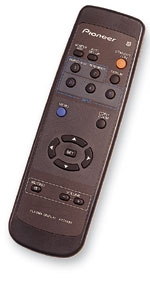Plasma Paradise Page 2
Pioneer Elite PRO-1000HDi The 50-inch PRO-1000HDi ($14,500) from Pioneer's Elite line offers one thing the other two sets don't: an HDMI (High-Definition Multimedia Interface) input. This little jack is the next-generation version of DVI, providing a pure digital signal from an HDTV tuner, satellite receiver, or DVD player. Unlike DVI, HDMI also carries audio signals, and it's compatible with DVI equipment (you'll need an adapter like Panasonic's $80 DVI-to-HDMI cable). But I can't say any more about HDMI because I couldn't test it - no source components equipped with HDMI outputs were available at this writing.

The Elite PRO-1000HDi cuts a classy figure. Its frame is thick, but the distinctive piano-gloss finish makes it one of the most attractive plasma panels I've seen. There's no TV tuner or speakers, so you'll need an external tuner even for watching regular TV. You can plug speakers directly into the panel - its puny 2-watt-per-channel amp ensures that the neighbors won't complain about excess volume.
You'll need to buy inexpensive adapters to convert the pro-style BNC jacks to accept regular RCA component- and composite-video cables. Otherwise the jack selection is standard fare, with a VGA computer input in addition to that BNC component-video input, which also accepts RGB signals from computer and video processors.
 The simple remote doesn't have backlighting or the ability to control a rack full of gear, which is surprising given the set's price. It does give you extremely convenient direct access to each input, however. A Screen Size button stepped me through the four display modes: 4:3 with gray bars on the sides, Zoom for expanding letterboxed shows to fill the screen, Full for widescreen images, and Wide to fill it by stretching the sides more than the center, which avoided cropping and prevented the head of CNN's Aaron Brown from ballooning, but played havoc with the news crawl at the bottom of the screen. The button has no effect on HDTV material, so you'll have to watch nonwidescreen high-def shows with bars to either side or else change the display mode at the source.
The simple remote doesn't have backlighting or the ability to control a rack full of gear, which is surprising given the set's price. It does give you extremely convenient direct access to each input, however. A Screen Size button stepped me through the four display modes: 4:3 with gray bars on the sides, Zoom for expanding letterboxed shows to fill the screen, Full for widescreen images, and Wide to fill it by stretching the sides more than the center, which avoided cropping and prevented the head of CNN's Aaron Brown from ballooning, but played havoc with the news crawl at the bottom of the screen. The button has no effect on HDTV material, so you'll have to watch nonwidescreen high-def shows with bars to either side or else change the display mode at the source.
While Pioneer's menu system uses a simple layout littered with technical terms, it does deliver a few conveniences, including the ability to name inputs using a virtual keyboard. I could save my settings for contrast, brightness, and so on for each input, and the five color-temperature presets are more than most HDTVs offer (Mid Low came closest to the NTSC standard). The PureCinema video processor has settings for HQ (the default), Standard, and off. HQ did a great job of detecting 2:3 pulldown in film-based DVDs and cleaning up jagged lines and other artifacts. Standard, which was less effective, is designed for situations where the video lags behind the audio - this didn't occur in my tests.
When I turned to The Hulk for some critical viewing, I immediately noticed the sharpness of the text and graphics on the menus and opening credits. So I quickly skipped to the big transformation, when Banner first becomes the Hulk, to see how well the Pioneer dealt with difficult dark scenes. As usual with plasma TVs, blacks didn't look completely black, but they were exceptionally clean, and shadows displayed comparably fine detail.
| Pioneer Elite PRO-1000HDi |
| DIMENSIONS (WxHxD) 49 5/8 inches wide, 30 5/8 inches high, 4 1/8 inches deep WEIGHT 103 pounds PRICE $14,500 MANUFACTURER Pioneer Electronics USA, Dept. S&V, 2265 220th St., Long Beach, CA 90810; www.pioneerelectronics.com; 800-746-6337 |
After being captured, the green rage machine breaks free and bursts into the desert sunlight, and that's where the Pioneer really started to shine. I almost forgot that the Hulk was a computer-generated character, thanks in part to the Pioneer's sharp picture. When he gets up after dodging mortars and looks angrily toward the camera, I saw the fine sheen of dust and dirt dulling his green skin, the rippling veins and muscles still clearly visible. I caught glimpses of tiny sand particles in the air as he fell after deflecting a tank round at close range.
Colors also looked lush and alive. The intense rust-colored lichen seen during the Hulk's brief desert reverie was brilliant, the green of the sage appropriately pale and not oversaturated, the numerous earth tones distinct and realistic. Against all this his green skin stood out like an alien chemical, and his outsized purple shorts seemed downright comical.
Moving on to HDTV, I again watched the shuttle launch on the D-VHS version of Digital Video Essentials. Both the 1080i and 720p tapes looked extremely good, with excellent detail and color. I saw every ridge and knick in the tiles on the nose cone, and the edges of the pipes and struts in the gantry were perfectly clean. The 720p version looked slightly sharper, with a tiny bit of extra crispness along the edge of one of the support buttresses, for example.
The Pioneer Elite PRO-1000HDi isn't for people on a tight budget, but its striking appearance, exceptional video performance, and forward-looking HDMI input will please those who can afford it.
PDF: In the Lab PDF: Features Checklist













































